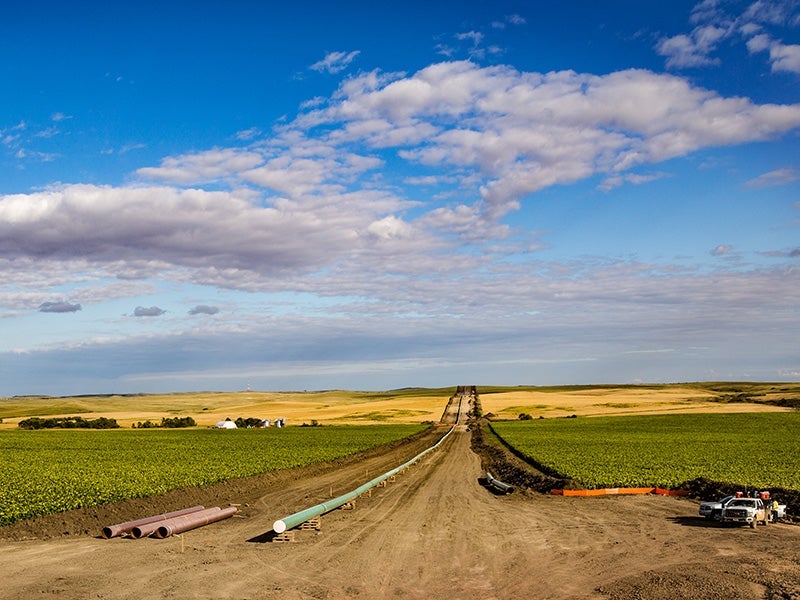Dakota Access Update: The Oil Will Keep Flowing; The Fight Continues
The Earthjustice attorney representing the Standing Rock Sioux explains the Oct. 11 ruling on the case, and where the legal process goes next.

The federal court overseeing the Standing Rock Sioux Tribe’s lawsuit over the Dakota Access Pipeline (DAPL) today ruled that the pipeline can continue operations while a new environmental review is underway.
Here’s some explanation of what happened:
What’s the background of this case?
When Energy Transfer Partners proposed a new 1,200-mile oil pipeline from the Bakken oil fields to the Midwest, it chose a route crossing the Missouri River just yards upstream from the Standing Rock Sioux reservation. The Tribe’s principled resistance to the project captured the attention of the entire world, leading to historic protests at the remote site in North Dakota. The Obama administration vindicated the Tribe’s concerns when it blocked the final permits to cross the Missouri River and promised a full environmental review that looked at the Tribe’s treaty rights as well as alternative routes.
Within days of his inauguration, however, Donald Trump ordered the permits granted. The Tribe filed a lawsuit to challenge this decision, but construction was completed while the case was proceeding.
In June, just weeks after pipeline operations had begun, the U.S. District Court for the District of Columbia ruled for the Tribe that the Army Corps had not complied with environmental review laws before issuing permits for the pipeline to cross the Missouri River.
The Army Corp’s lack of compliance lay at the heart of the Tribe’s concerns about the project—the failure to address robust expert critiques of oil spill risk, the failure to address the impacts of an oil spill on the Tribe’s treaty rights and the failure to adequately consider the environmental justice implications of siting the pipeline just upstream of the Standing Rock reservation.
In its June decision, the court ordered the Army Corps to do a new analysis of these critical issues, in what is called a “remand” process. The court ordered separate briefing to assess whether the pipeline should be shut down while the remand process is going on. Today’s decision addresses that question.
What did the court decide today?
In a 28-page opinion, the court weighed two factors to determine whether or not the pipeline should be shut down.
First, it asked whether it was “possible” that the Corps would be able to justify its previous decision not to conduct a full environmental review once the remand is complete. The court answered that question in the affirmative.
Second, it assessed the disruptive consequences if the pipeline were shut down. On this issue, the court largely rejected Energy Transfer Partners’ claims that a shutdown would cause substantial economic harm, finding that the company bore some responsibility for its situation by starting operations while the case was being litigated. However, the court found that the first factor was sufficient to rule against shutting down the pipeline.
What about other protective measures?
In its legal briefs, the Tribe had asked that if the pipeline were not shut down, then the court should impose additional measures to reduce the risk of oil spills to protect the Tribe. Specifically, the Tribe called for better oil spill response planning, a third-party audit of DAPL’s compliance, and better public reporting.
The court rejected the Corps’ and DAPL’s argument that the court didn’t have authority to impose such measures, but offered an opportunity for them to respond on the substance of the Tribe’s proposal. The details and timing of this process will be worked out at a status conference next week.
Can this decision be appealed?
Because the district court case remains live, and the remand process is underway, this is not an appealable decision at this time.
What’s next for this case?
The Tribe intends to focus on the remand process and has a technical team of experts assisting it in providing input. The Corps has invited the Tribe to provide input into the remand, and that process is currently underway.
The goal—as it has been from the beginning—is to demonstrate that the risks of an oil spill, and the impacts on the Tribe, are sufficient to require a full environmental impact statement to be prepared, which would reopen the discussion around an appropriate location for crossing the Missouri River. The Corps has stated that process should be complete by April of next year. The court admonished the Corps not to treat this process as a “bureaucratic formality” but to give “serious consideration” to the errors identified by the court.
The Standing Rock Litigation: FAQ, Legal Documents, Timeline
